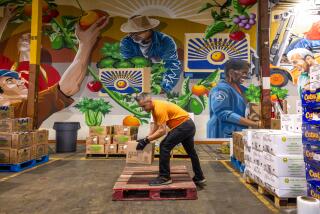Book review: ‘Fair Food’ by Oran B. Hesterman
- Share via
In Ann Arbor, Mich., there’s a hospital with a farm on the grounds that one day could provide patients’ food. Michigan’s Double Up Food Bucks Program uses grants and donations to enable food stamp recipients to double their buying power if they buy locally grown produce.
In South Los Angeles, Community Services Unlimited has a small urban farm and sells the produce in a weekly program. And in Philadelphia and other cities, food hubs have been established to market and distribute locally grown food. There are thousands of farm-to-school programs; eight years ago, there were four.
These are among the programs cited by Oran B. Hesterman, whose nonprofit Fair Food Network (www.fairfoodnetwork.org) aims to change the landscape of who gets to eat what and how it gets to us. He has outlined what’s gone awry and how it might be repaired in his new book, “Fair Food: Growing a Healthy, Sustainable Food System for All.”
Hesterman’s work follows a library’s worth of books and movies that have questioned the wisdom of enormous corn and soybean farms, the morals of food advertising, the dangers of fast food diets, the health of confined animal feeding operations and more.
But while Hesterman argues that the status quo is not working, he hopes to inspire readers to do more than plant tomatoes in their yards. He wants a food system that values “equity, diversity, ecological integrity and economic viability,” and much of the book is taken up with examples of people and institutions working toward a just food system.
Getting to “Fair Food” in part means looking around the corner rather than around the country, and focusing public resources on restoring local food systems.
He is trying to nudge people to become “engaged citizens” who fight for farm-worker rights or lobby their representatives or set up buying clubs to support local farms.
“My concern is making sure that those living in inner-city neighborhoods have access to tomatoes in a form other than a ketchup packet at a fast food joint,” Hesterman writes.
Only about 2% of the food bought in the United States comes from local and sustainable sources, Hesterman says, citing calculations from the Kellogg Foundation in 2007. (It’s likely that’s gone up, as the mantra of “eat local” has only become more insistent in the last few years.)
He argues that a local food system means more spending in a community and that those dollars not only support farmers but also get returned to the local economy in other ways. So shopping at farmers markets helps, but he wants people to fight for local food in schools and other institutions.
Public policy is working to keep people from hunger but isn’t keeping them from becoming obese, Hesterman says. An insurance executive told him that by 2018, obesity and its related diseases will cost $345 billion — a price tag that cannot be supported by the insurance industry or by the country, Hesterman said in an interview before a recent reading and book signing at Eso Won Books in L.A.
“We are not doing enough today to shift the food environment,” he said. “This is the core issue, and we have to get it right” if we hope to feed a planet that is likely to add 3 billion people in the next three or four decades.
“This is a movement that cannot afford the luxury of remaining in primarily the upper-middle- and middle-class white communities,” he said.
“Fair Food” introduces many examples of the engaged citizens he seeks, and it has a hefty chapter of resources around the country to help people get started. And Hesterman is not without optimism, in part because of First Lady Michelle Obama’s program to combat childhood obesity.
“It’s fantastic to have leadership from the White House articulating the need for change in the food system,” he said. The first lady “recognizes it is the most important issue facing people today.”
More to Read
The biggest entertainment stories
Get our big stories about Hollywood, film, television, music, arts, culture and more right in your inbox as soon as they publish.
You may occasionally receive promotional content from the Los Angeles Times.











